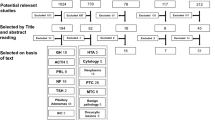Abstract
No current histological or cytological indices can distinguish reliably malignant from benign tumors in neuroendocrine tumors, including pheochromocytomas, pancreatic endocrine tumors, and carcinoid tumors. We investigated immunohistochemically the expression of Ki-67 in 52 neuroendocrine tumors, including 17 pheochromocytomas, 9 pancreatic endocrine tumors, 23 carcinoid tumors, 2 neuroendocrine carcinomas (NEC), and 1 neuroblastoma with liver metastasis. Of the 52 tumors, distant metastasis was observed in 4 pheochromocytomas, 2 pancreatic endocrine tumors, 4 carcinoids, 2 NEC, and 1 neuroblastoma. We classified these tumors into 3 groups; Groups A, B, and C, depending on the number of Ki-67-positive cells counted under a 200 x magnified field. Expression of Ki-67 was extremely high in group A (> 50 labeled nuclei/field), moderately high in group B (20–50 labeled nuclei), and very low in group C (< 10 labeled nuclei). There was a significant correlation between expression of Ki-67 and tumor progression. The tumors in group A progressed rapidly with the worst outcome; the tumors in group B progressed slowly but with a bad outcome; and the tumors in group C had no metastasis and a good prognosis. Ki-67 is an excellent indicator to assess progression of neuroendocrine tumors.
Similar content being viewed by others
References
Barnard N, Hall P, Lemoine N, Kadar N. Proliferative index in breast carcinoma determined in situ by Ki-67 immunostaining and its relationship to clinical and pathological variables. J Pathol 152:287–295, 1987.
Bouzubar N, Walker KJ, Griffiths K, Ellis IO, Elston LW, Robertson JFR, Blammy RW, Nicholson RI. Ki-67 immunostaining in primary breast cancer. Pathological and clinical associations. Br J Cancer 59:943- 947, 1989.
Hall PA, Richards MA, Gregory WM, d’Ardenne AJ, Lister TA, Stansfeld AG. The prognostic value of Ki-67 immunostaining in non-Hodgkin’s lymphoma. J Pathol 154: 223–235, 1988.
Isola J, Helin H, Helle M, Kallioniemi O-P. Evaluation of cell proliferation in breast carcinoma: Comparison of Ki-67 immunohistochemistry, DNA flow cytometry and mitotic count. Cancer 65:1180–1185, 1990.
Isola J, Kallioniemi O-P, Korte J-M, Wahlstrom T, Aine R, Helle M, Helin H. Steroid receptors and Ki-67 reactivity in ovarian cancer and in normal ovary: Correlation with DNA flow cytometry, biochemical receptor assay, and patient survival. J Pathol 162:295–301, 1990.
Kimura N, Nagura H. A comparative study of neuroendocrine carcinoma and carcinoid tumor with special reference to expression of HLA-DR antigen and PCNA. Zentrlbl Pathol 139:171–175, 1993.
Kimura N, Sasano N. A comparative study between malignant and benign pheochromocytoma using morphometry, cytophotometry, and immunohistochemistry. In: Lechago J, Kameya T, eds. Endocrine pathology update, vol 1. New York; Field and Wood, 1990. Pp 99–118.
Kimura N, Watanabe M, Kubota M, Oonuma T, Mizokami A, Nagura H. Quantitative analysis of immunohistochemical androgen receptor and Ki-67 in prostatic carcinoma and its relationship to histologic grade. Oncol Rep 1:69–73, 1994.
Kimura N, Watanabe M, Oonuma T, Miura W, Noshiro T, Miura Y, Nagura H. DNA ploidy of pheochromocytoma on cytology specimen by image analysis. Endocr Pathol 5:178–182, 1994.
Kloppel G, In’tVeld P, Stamm B, Heitz PU. The endocrine pancreas. In: Kovacs K, Asa S, eds. Functional endocrine pathology, vol 1. Oxford: Blackwell Scientific, 1991. Pp 396–457.
Lechago J, Shah IA. The endocrine digestive system. In: Kovacs K, Asa S, eds. Functional endocrine pathology, vol 1. Oxford: Blackwell Scientific, 1991. Pp 458–477.
Linnoila RI, Keiser HR, Steinberg SM, Lack E. Histopathology of benign versus malignant sympathoadrenal paragangliomas: Clinicopathologic study of 120 cases including unusual histologic features. Hum Pathol 21:1168–1180, 1990.
Medeiros LJ, Wolf BC, Balogh K, Federman M. Adrenal pheochromocytoma: A clinicopathologic review of 60 cases. Hum Pathol 16:580–589, 1985.
Ueda T, Aozasa K, Tsuzimoto M, Ohsawa M, Uchida A, Aoki Y, Ono K, Matsumoto K. Prognostic significance of Ki-67 reactivity in soft tissue sarcomas. Cancer 63:1607–1611, 1989.
Yonemura Y, Ooyama S, Sugiyama K, Ninomiya I, Kamata T, Yamaguchi A, Matsmoto H, Miyazaki I. Growth fractions in gastric carcinomas determined with monoclonal antibody Ki-67. Cancer 65: 1130–1134, 1990.
Author information
Authors and Affiliations
Rights and permissions
About this article
Cite this article
Kimura, N., Miura, W., Noshiro, T. et al. Ki-67 is an indicator of progression of neuroendocrine tumors. Endocr Pathol 5, 223–228 (1994). https://doi.org/10.1007/BF02921490
Published:
Issue Date:
DOI: https://doi.org/10.1007/BF02921490




